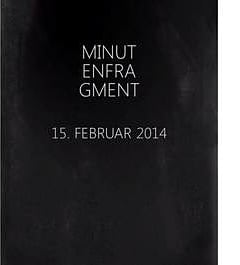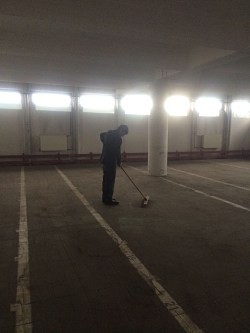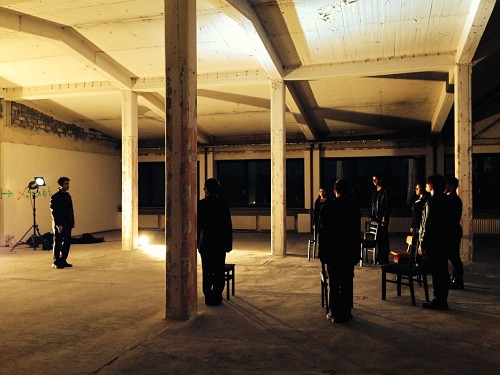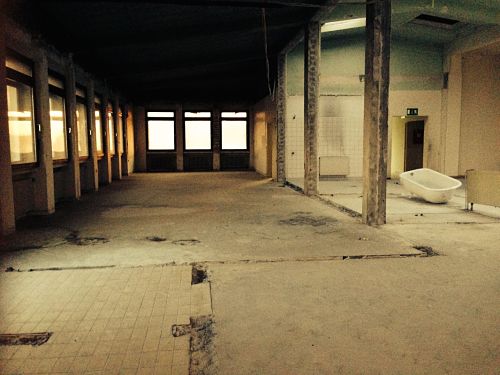“Early in the morning”, one of my informants, a 39 year-old Iranian political refugee and former lecturer at the University of Teheran told me, “I would wake up to screams. I then knew another family was being deported from the asylum camp. The police knock on their doors and tell them that they have only fifteen minutes to pack their things. Just 15 Minutes, can you imagine?”
Over the course of the eight-months refugee theatre project RUHRORTER and their performance-themed public interventions called 15 MINUTES, 8 out of originally 15 refugee actors were deported, often late in the night after rehearsals or early in the morning. The temporal frame ‘15 Minutes’ was a recurring theme for this project. It served as a metaphor of my refugee actor informant’s suspension in a continued state of what I refer to as ‘precarious temporality’.
Introduction
By December 2013, almost eight million people in Germany held non-German citizenship, marking the highest total population in any EU member state. This paper looks at some of the practical and aesthetic experiences of asylum seekers and refugees in the country’s structurally most disadvantaged region, the West German Ruhr area. Formerly the country’s industrial heartland attracting millions of guest-workers that became permanent residents, the region now bears the burden of some of Germany’s most heavily indebted municipalities, such as Oberhausen – dubbed ‘Germany’s Detroit’ by the New York Times (2013), where post-war wasteland and high unemployment rates outweigh nostalgic rejuvenation campaigns based on long-gone pioneering industries.
My recent doctoral fieldwork explored the tradition of the German Theater an der Ruhr – a theatre that has conducted pioneering collaborations with refugees, such as the Roma theatre Pralipe, for three decades. Over the course of this field research, I accompanied a young Turkish director during his theatre project supported by the Theater an der Ruhr with refugees and asylum seekers from this town, Oberhausen. His project temporarily transformed an abandoned post-industrial multi-storey refugee camp that once housed victims of the Yugoslav wars, which is located in the local industrial harbour, into a theatre and installation venue. This was significant insofar as the majority of initial participants of the project were Roma and Sinti families from former Yugoslav countries, particularly Serbia. A recent EU-decision declared countries of the Western Balkans ‘safe countries of origin’, effectively ruling out asylum applications on the grounds that ‘no persecution or violence’ could be expected in those countries. In Oberhausen, nearly all Serbian and Macedonian Roma families who applied for asylum were deported, despite evidence of persecution, violence, and serious trauma among refugees.
Driven by my observations about how the project’s participants dealt with several other Romani participants’ deportations during production phases, this post explores how the art project reflects the actors’ ‘precarious temporalities’. What I mean by that is the following: I would like to suggest that for the refugees I worked with during the theatre project, ‘the end of emergency’ was nowhere in sight as long as their official legal status kept them in a state of ‘toleration’ or Duldung in German, a legal term denoting the ‘temporary suspension of deportation’. Many actors in the group subjected to the legal status of Duldung were traumatised by two kinds of extreme events that interlock. One was the usually singular but often life-threatening escape from their home-countries. The second traumatising event, less spectacular yet more continually disconcerting, was the continued unrest created by the constant possibility of being deported. In this way, this post continues a concern raised by Heike Drotbohm and Ines Hasselberg in their earlier post. They write:
Deportation, the forced removal of foreign nationals from a given national territory, is not a singular event. It is a process that begins long before, and carries on long after, the removal from one country to another takes place.
The project RUHRORTER
The theatre project RUHRORTER, which I accompanied, advocated an introspective understanding of political art that sought to create new spaces for “political self-reflection” and new forms of engagement with precariousness that are not based on documentary exposure. It rejected artistic forms that claim political momentum by reducing character to actor, by inviting migrants, people with disabilities, or other minorities to act only as themselves and not as actors capable of inventing new scenarios. The critical momentum of such an approach, Adem said to me, rests solely on this reduction of art to its representation and thus implicit reification of the acting minority.
Moving away from such documentary exposure, the project’s main focus was an eight-months rehearsal process for a theatre piece that problematized the actors’ precariousness by abandoning linear narrative and embracing fragmentary, dream-like scenes that had abstracted the actors’ personal experiences into scenarios, themes, and images. What is important to note is that the project’s aesthetic was inspired by the specific experience of being a ‘tolerated’ refugee ‘temporarily suspended from deportation’ and forced to live in an asylum camp. That is why the project took place on the fourth floor of the abandoned building, which had the eerie appearance of an industrial church with a podium at the back that seemed like a stairway to heaven when the light rays came through large windows at the back of the room. The play’s title – Two Skies/Two Heavens (Zwei Himmel) was inspired by this ‘stage-setting’.
The camp
Since the specific experience of regimented space and precarious temporality was so central to the project, its director often asked me to accompany him to refugee camps in Oberhausen, all of which were mixed camps, yet some of which had opened additional capacities for Syrian refugees. When we initially drove to various refugee camps in the Ruhr valley, we were struck by one observation about the politics of space: since many political and cultural decisions in Germany are delegated not to the federal states but in fact to the municipalities and cities, differences in dealing with refugees can be stark. While one city, Mülheim, had decided about twenty years ago to accommodate refugees in decentralized flats ‘integrated’ into their neighbouring communities in the city-centre, the main municipal reference point for the project, Oberhausen, houses refugees in gated container camps. The situation in the camp in Oberhausen, where most of the project’s participants came from, was catastrophic.
Water and mud sat on the concrete courtyard, often running into the apartments on the ground floor, toilets were broken and shared by dozens of people, there was no care for traumatised persons. One of our project participants, the Iranian industrial designer and former lecturer at the University of Teheran who fled for political reasons, kept telling us how hard it was for him to work in a small room he shared with four Afghani men who drank heavily, were seriously traumatised, and often screamed at night, as he retold me. What didn’t make the experience much nicer for him was the anxiety over racist attacks. In fact, from his window, he overlooked nothing other than a German shepherd breeding farm run by a man with shaven head and right-wing hooligan logos on his white Mercedes car.
Duldung
These spatial and social arrangements convinced Adem Köstereli, the project director, that his project should take its lead from the legal underpinnings of such regimented space and the experience therein. He described this as follows:
the refugee is object (Gegenstand) of a legal bureaucracy; he is not a subject, but degraded to a thing-like (verdinglicht) status. The refugee is the manifestation of Agamben’s Homo sacer, that is, the human being reduced and thingified (vedinglicht) to bare life.
What is more, one of the project’s observations was the significance of what I refer to as the precarious temporality. Both an object of reflection and a frequent topic of conversation among us, the precarious temporalities of the project’s participants revolved around an existential temporal and spatial legal regulation referred to as Duldung. According to the German framework for the right of residence (§60a, Abs. 4, AufenthG), Duldung is the legal term for a temporary suspension of deportation. If in a state of Duldung, refugees are not granted asylum or a residence permit, not even a temporary working permit, they are merely ‘tolerated’ and ‘temporarily suspended from deportation’. In fact, the word itself translates as ‘to bear’, ‘to tolerate’, and even as ‘to endure’. Many live in a state of continued anxiety that their ‘suspension from deportation’ might run out, while others are caught in a situation of repeated ‘Duldung’ or ‘chain-Duldung’, without ever being granted proper asylum (§95, Abs. 1, Nr. 2, AufenthG). At the end of 2011, some 90.000 foreigners lived with and ‘endured’ such a Duldung in Germany.
A Duldung furthermore has very pragmatic legal implications that are severe for the (impossible) reintegration into normality after seeking refuge: a) there is no legal entitlement to integration-course for language-learning, since a residence permit is required (§44 Abs. 1 AufenthG), b) an asylum-seeker with Duldung has no right to social benefits, c) no right to work, and d) no right to leave the federal state to which he/she has been assigned (§61 AufenthG).
15 Minutes
The project integrated into the production of a theatre and installation a range of performance-based interventions called 15 MINUTES. These interventions did not just respond to the precarious temporality of the refugees. It also responded to several deportations that occurred in the morning hours after rehearsals, sometimes between two rehearsals. Adem contextualised the artistic interventions as follows:
Refugees are supposed to be informed about scheduled deportations, according to §60a, Abs. 5 AufenthG. Yet, official authorities are not obliged to do so in cases where individuals have not been granted an extended Duldung. Therefore, authorities often proceed by picking up selected individuals in the middle of the night.
He told me that the series of interventions 15 MINUTES is a reaction to and reflection on this legal notion of Duldung, which he described as a state administered regulations of their temporal existence.
 Accompanying the theatre piece rehearsals, Adem organised three such public performance interventions. The first one was called Minutenfragment – Minute Fragment and took place in February 2014 in the asylum camp in Oberhausen. Following a theatre workshop for children in the local nursery, the project participants staged a theatre scene that emerged during rehearsals, which problematised deportation. It did so by staging an orchestra scene in the central square in the refugee camp. In rehearsals and in conversations with the actors, Adem explained that the idea behind this scene was the macabre fact that Jews were often forced to play music and perform theatre in Nazi concentration camps. He thus wanted to problematise the idea of making art under the pressure of potential deportation and violence or death. A quote from the project’s website reads:
Accompanying the theatre piece rehearsals, Adem organised three such public performance interventions. The first one was called Minutenfragment – Minute Fragment and took place in February 2014 in the asylum camp in Oberhausen. Following a theatre workshop for children in the local nursery, the project participants staged a theatre scene that emerged during rehearsals, which problematised deportation. It did so by staging an orchestra scene in the central square in the refugee camp. In rehearsals and in conversations with the actors, Adem explained that the idea behind this scene was the macabre fact that Jews were often forced to play music and perform theatre in Nazi concentration camps. He thus wanted to problematise the idea of making art under the pressure of potential deportation and violence or death. A quote from the project’s website reads:
this thematically important scene is addressed at the current inhabitants of the camp and those former ones who participated in our theatre project and have now been deported.
A second event, entitled 15 MINUTES was staged in the high street of Mülheim two weeks later. Following announcements in the local newspaper, one of Adem’s friends and I positioned ourselves in the high street and asked passers-by what they would take with them if they had only 15 minutes to pack their things before being forced to leave the country. Selected responses with an accompanying article were published in the local press and later used in an installation that followed the theatre piece in the abandoned asylum camp that was turned into the project’s theatre venue.
In addition to the ‘professionally conducted’ interviews we conducted with about 50 citizens, participants of the project had rehearsed various performance-based interventions that they staged at the same time and that undermined the orderly nature of our interviewing. While the interviews proceeded, they walked around the High Street with large alarm-clocks in their hands, sitting down on a bench and letting it ring, or just standing next to someone and doing the same, sometimes running, sometimes walking very slowly, but never in a group so that the element of surprise and uncanniness prevailed.
The performance intervention, the participants explained to me, was meant to bring to public attention to the precarious, and controlled temporalities of refugees and asylum-seekers, particularly those affected by a Duldung.
One Serbian Roma, several times deported participant of the project commented on this in a portrait that I wrote for the project’s local newspaper column. He claimed that this angst of deportation diffused his unsettled state into his everyday life, something he thought was true for his family, too. Last year, he was deported a week before the premiere of a previous theatre piece. This year in January, his Duldung had been extended to the end of March. He described his situation more eloquently than I could by saying to me:
My life is like a journey on a boat: I constantly rock from one side to another, I drift. I try to arrive somewhere – for a month, a year, maybe longer – to build up a life, to be able to live. But without a soil under your feet, you are never accepted, you cannot plan your future: you live in your remembered past.
Manifesting Absence – Timing Precariousness
 Based on this experience, both of the spatially inscribed absence of deported refugees and the continually extended ‘temporary suspension of deportation’, the group decided, as a third ‘intervention’ to create a short film entitled RUHRORTER. The idea behind the film was simple yet arresting: to show someone, who dreams of waking up in the asylum camp he had once lived, yet instead of seeing the children he remembered playing with, he only catches absurd glimpses of these memories, enacted by ghost-like appearances of persons in the abandoned building. The film ends just after a version of the orchestra scene that was at the heart of the first performance in the asylum camp in Oberhausen. In the film, this scene marks the moment at which the narrator realises he had been dreaming.
Based on this experience, both of the spatially inscribed absence of deported refugees and the continually extended ‘temporary suspension of deportation’, the group decided, as a third ‘intervention’ to create a short film entitled RUHRORTER. The idea behind the film was simple yet arresting: to show someone, who dreams of waking up in the asylum camp he had once lived, yet instead of seeing the children he remembered playing with, he only catches absurd glimpses of these memories, enacted by ghost-like appearances of persons in the abandoned building. The film ends just after a version of the orchestra scene that was at the heart of the first performance in the asylum camp in Oberhausen. In the film, this scene marks the moment at which the narrator realises he had been dreaming.
Shot in the building where the group spent many months, often until late at night, working and rehearsing, Adem and the participants invited children and friends of participants from the asylum camp in Oberhausen to help out, act, and socialise, turning the shoot into a participatory event. Adem wanted to bring life back into the dusty buildings that still bore the traces of children playing there once, in the form of names, cartoons, stickers attached and itched into the walls.
One particular anecdote during the filming brought the actors’ precarious temporality to the fore. On the day, many children asked me why everywhere on the walls the verb “bleibt” (“staying” or “this stays” in English) was written in neon green colour, often misspelt as ‘bleit’. I explained that after the building had become disused some ten years ago, the official owner had torn down all but the so-called ‘load-bearing walls’. So while on the floors one could still make out the former lines of walls of the old rooms given to asylum seekers, the ‘load-bearing walls’ were marked as ‘needing to stay’.
A discussion ensued about what it means to ‘have the right to stay’, and why some people from the group had been deported and not others. Explaining the notion of bleiben or ‘staying’ to young actors whose lives were subjected to the legal temporary suspension of deportation was only one of the many ethically complicated situations during this project.
Their involvement in the filming brought one Egyptian refugee to reflect on her situation. She had joined the project to escape the isolation of and lack of support for her family in the Oberhausen camp. We later spoke about this in greater detail for an article on her situation in the local press. She said:
I have so many memories and images in my head, of Egypt, of my family. I worry about loss, all day, each day. I cannot sleep, have not slept in a long time. This unrest makes me feel as if I slept with an open door into which people could walk at any moment. Taking part in this film was like acting out these dreams and distancing myself from them, taking control of them and, in that way, of my life and time.
Concluding Remarks
As I have explored, the concept of Duldung, or ‘temporary suspension of deportation’ is not merely a legal term, it became a prism both for the refugee participants’ of the RUHRORTER project and the project’s own aesthetic performances. Focusing on the experience of regimented camp spatiality and legally regulated precarious temporality, Adem and the participants focused less on a direct response or public political intervention to the state’s refugee politics. Rather, they designed a series of artistically different engagements with what the precarious temporality (and spatiality) means subjectively and artistically for refugees in the Ruhr valley. Adem’s emphasis on long and extended rehearsals became a way for the participants to tease out, abstract, and distance themselves from their own personal (hi)stories and to transform them into abstract and artistic forms. In addition, it needs to be noted, the two public performances, one more abstract than the other, as well as the film, were only side-projects to the theatre and installation, the political and ethical practice and significance of which I describe elsewhere.
They were significant nonetheless as they emphasised most intensely the two conclusions I draw from my ethnographic work with the refugee project. These are, first, that for the refugee actors I worked with, there were two sorts of critical events: one from their respective home-country to Germany (that is not singular, but often cyclical, repeated) and another that is pervasive, daily, less hard to grasp. The former was often the tale of escape and refuge that left many with scarred memories of rupture and violence, while the latter created a diffused sense of uncertainty harder to pinpoint, yet articulated often as an unsettling inability to settle down, to rest, to sleep. This unsettling state of potential deportation could be described, using both an ethnographic and an analytic term, as my refugee informants’ precarious temporality. The second conclusion is that the project RUHRORTER, its performance series 15 Minutes, and the short film I described in this post all problematise the significance of precarious temporality for the refugee as legal state-subject. The deliberately non-documentary nature of the art and theatre project provided “freedom from my other anxious selves”, to put it in one informants’ words:
Walking through the gated doors of the asylum camp that became our theatre venue, I began seeing every marker of a now-deported person as a bit of memory, as a trace for imagination, as a possibility for our own re-creation. Our time here began to extend into our fantasy, relieving me from the concrete and rigid here and now.






